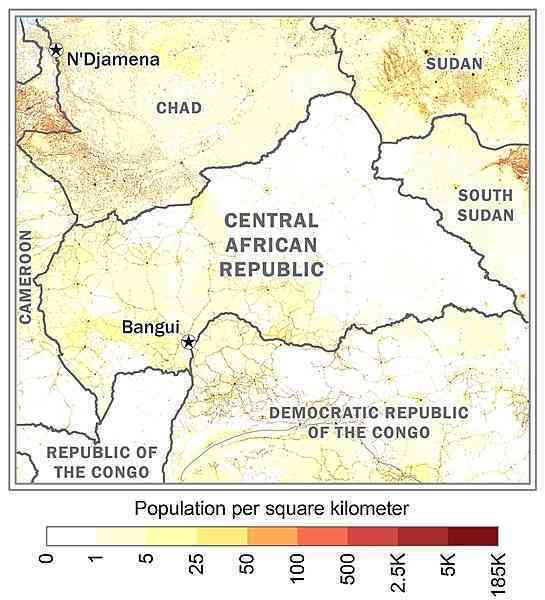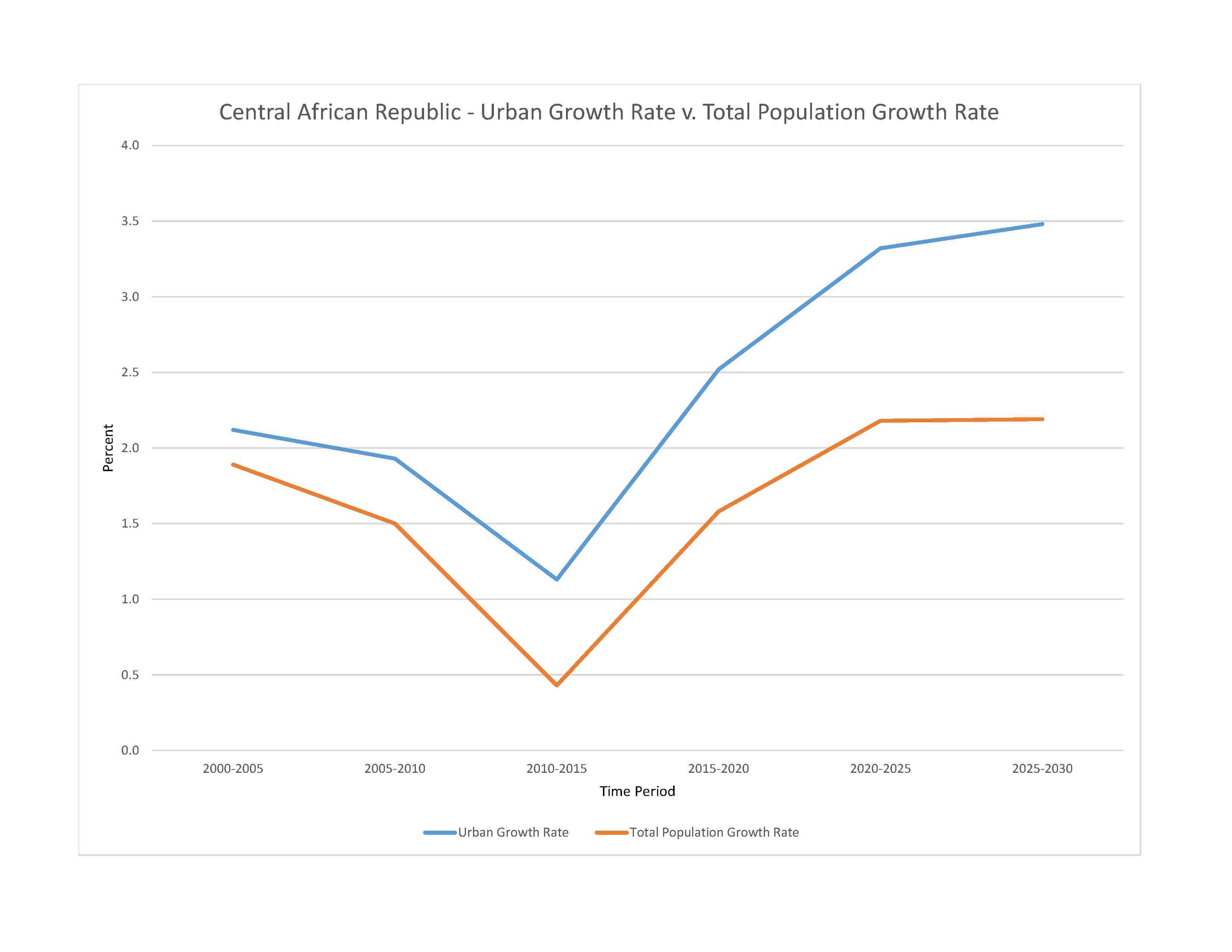
5,552,228 (2023 est.)
noun: Central African(s)
adjective: Central African
Baya 28.8%, Banda 22.9%, Mandjia 9.9%, Sara 7.9%, M'Baka-Bantu 7.9%, Arab-Fulani (Peuhl) 6%, Mbum 6%, Ngbanki 5.5%, Zande-Nzakara 3%, other Central African Republic ethnic groups 2%, non-Central African Republic ethnic groups .1% (2003 est.)
French (official), Sangho (lingua franca and national language), tribal languages
Christian 89%, Muslim 9%, folk religionist 1%, unaffiliated 1% (2020 est.)
note: animistic beliefs and practices strongly influence the Christian majority
The Central African Republic’s (CAR) humanitarian crisis has worsened since the coup of March 2013. CAR’s high mortality rate and low life expectancy are attributed to elevated rates of preventable and treatable diseases (including malaria and malnutrition), an inadequate health care system, precarious food security, and armed conflict. Some of the worst mortality rates are in western CAR’s diamond mining region, which has been impoverished because of government attempts to control the diamond trade and the fall in industrial diamond prices. To make matters worse, the government and international donors have reduced health funding in recent years. The CAR’s weak educational system and low literacy rate have also suffered as a result of the country’s ongoing conflict. Schools are closed, qualified teachers are scarce, infrastructure, funding, and supplies are lacking and subject to looting, and many students and teachers have been displaced by violence.
Rampant poverty, human rights violations, unemployment, poor infrastructure, and a lack of security and stability have led to forced displacement internally and externally. Since the political crisis that resulted in CAR’s March 2013 coup began in December 2012, approximately 600,000 people have fled to Chad, the Democratic Republic of the Congo, and other neighboring countries, while another estimated 515,000 were displaced internally as of December 2022. The UN has urged countries to refrain from repatriating CAR refugees amid the heightened lawlessness.
(2019)
0-14 years: 38.84% (male 1,104,007/female 1,052,411)
15-64 years: 57.71% (male 1,577,102/female 1,627,133)
65 years and over: 3.45% (2023 est.) (male 83,431/female 108,144)
total dependency ratio: 102.8
youth dependency ratio: 97.7
elderly dependency ratio: 5.1
potential support ratio: 19.7 (2021 est.)
total: 20.2 years (2023 est.)
male: 19.5 years
female: 21.1 years
1.77% (2023 est.)
32.4 births/1,000 population (2023 est.)
11.5 deaths/1,000 population (2023 est.)
-3.2 migrant(s)/1,000 population (2023 est.)
majority of residents live in the western and central areas of the country, especially in and around the capital of Bangui as shown in this 
urban population: 43.6% of total population (2023)
rate of urbanization: 3.32% annual rate of change (2020-25 est.)

958,000 BANGUI (capital) (2023)
at birth: 1.03 male(s)/female
0-14 years: 1.05 male(s)/female
15-64 years: 0.97 male(s)/female
65 years and over: 0.77 male(s)/female
total population: 0.99 male(s)/female (2023 est.)
835 deaths/100,000 live births (2020 est.)
total: 81.7 deaths/1,000 live births (2023 est.)
male: 87.7 deaths/1,000 live births
female: 75.6 deaths/1,000 live births
total population: 56 years (2023 est.)
male: 54.6 years
female: 57.3 years
3.99 children born/woman (2023 est.)
1.97 (2023 est.)
17.8% (2019)
improved: urban: 83.9% of population
rural: 47.5% of population
total: 62.9% of population
unimproved: urban: 16.1% of population
rural: 52.5% of population
total: 37.1% of population (2020 est.)
9.4% of GDP (2020)
0.07 physicians/1,000 population (2018)
1 beds/1,000 population (2011)
improved: urban: 53.8% of population
rural: 12.4% of population
total: 29.9% of population
unimproved: urban: 46.2% of population
rural: 87.6% of population
total: 70.1% of population (2020 est.)
degree of risk: very high (2023)
food or waterborne diseases: bacterial and protozoal diarrhea, hepatitis A and E, and typhoid fever
vectorborne diseases: malaria, dengue fever, and sexually transmitted diseases: HIV/AIDS, hepatitis B (2024)
water contact diseases: schistosomiasis
animal contact diseases: rabies
note: on 31 August 2023, the US Centers for Disease Control and Prevention (CDC) issued a Travel Alert for polio in Africa; the Central African Republic is currently considered a high risk to travelers for circulating vaccine-derived polioviruses (cVDPV); vaccine-derived poliovirus (VDPV) is a strain of the weakened poliovirus that was initially included in oral polio vaccine (OPV) and that has changed over time and behaves more like the wild or naturally occurring virus; this means it can be spread more easily to people who are unvaccinated against polio and who come in contact with the stool or respiratory secretions, such as from a sneeze, of an “infected” person who received oral polio vaccine; the CDC recommends that before any international travel, anyone unvaccinated, incompletely vaccinated, or with an unknown polio vaccination status should complete the routine polio vaccine series; before travel to any high-risk destination, the CDC recommends that adults who previously completed the full, routine polio vaccine series receive a single, lifetime booster dose of polio vaccine
7.5% (2016)
total: 0.94 liters of pure alcohol (2019 est.)
beer: 0.55 liters of pure alcohol (2019 est.)
wine: 0.04 liters of pure alcohol (2019 est.)
spirits: 0.02 liters of pure alcohol (2019 est.)
other alcohols: 0.33 liters of pure alcohol (2019 est.)
20.5% (2019)
64.7% (2023 est.)
women married by age 15: 25.8%
women married by age 18: 61%
men married by age 18: 17.1% (2019 est.)
2.2% of GDP (2020 est.)
definition: age 15 and over can read and write
total population: 37.5%
male: 49.2%
female: 26.2% (2020)
total: 7 years
male: 8 years
female: 6 years (2012)
NOTE: The information regarding Central African Republic on this page is re-published from the 2024 World Fact Book of the United States Central Intelligence Agency and other sources. No claims are made regarding the accuracy of Central African Republic 2024 information contained here. All suggestions for corrections of any errors about Central African Republic 2024 should be addressed to the CIA or the source cited on each page.
This page was last modified 04 May 24, Copyright © 2024 ITA all rights reserved.